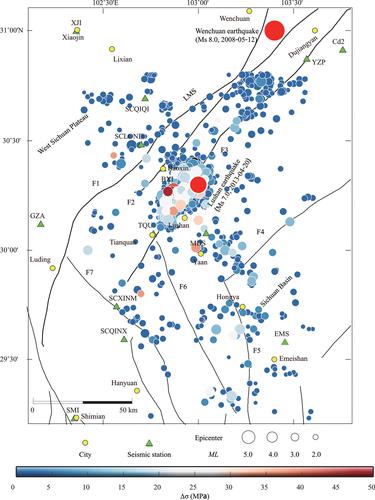当前位置:
X-MOL 学术
›
Acta Geol. Sinica Engl. Ed.
›
论文详情
Our official English website, www.x-mol.net, welcomes your feedback! (Note: you will need to create a separate account there.)
Spatial and Temporal Variations in Earthquake Stress Drops between the 2008 Wenchuan and 2013 Lushan Earthquakes
Acta Geologica Sinica-English Edition ( IF 3.3 ) Pub Date : 2020-10-08 , DOI: 10.1111/1755-6724.14582 Weiwei WU 1 , Feng LONG 1 , Mingjian LIANG 1 , Yaling WEI 1 , Wei SUN 1 , Xuefen CHEN 1 , Jing ZHAO 1
Acta Geologica Sinica-English Edition ( IF 3.3 ) Pub Date : 2020-10-08 , DOI: 10.1111/1755-6724.14582 Weiwei WU 1 , Feng LONG 1 , Mingjian LIANG 1 , Yaling WEI 1 , Wei SUN 1 , Xuefen CHEN 1 , Jing ZHAO 1
Affiliation

|
As a case study of spatial and temporal variations in earthquake stress drops between the 2008 Ms 8.0 Wenchuan and 2013 Ms 7.0 Lushan earthquakes, we computed 1828 stress‐drop values for earthquakes with magnitudes 1.7 ≤ ML ≤ 5.0 during an eight‐year time span before and after major earthquakes. We divide the study area into three subregions (the southern segment of the Longmen Shan fault zone; the southwestern junction of the Longmen Shan and Sichuan Basin; and the southwestern margin of the Sichuan Basin) and calculate individual event stress drops in each. The results show that regions of alternating high and low stress drop are found on either side of the southwestern segment of the Longmen Shan fault zone. During the two‐year period after the 2008 Ms 8.0 Wenchuan earthquake, the stress state of the southern Longmen Shan fault shows no significant change. A marked increase in stress level appears about 18 months before the 2013 Ms 7.0 Lushan earthquake near the Lushan hypocenter zone. Two months after the Ms 7.0 event, the stress drops suddenly attenuate, with significantly less seismic energy release per event. We find that changes in the patterns of high and low stress drop values are consistent with the process of stress accumulation or transfer from the pre‐mainshock to post‐mainshock periods. The results indicate that major earthquakes are the dominant cause of temporal and spatial evolution in stress levels. Stress drop variations show obvious temporal and spatial patterns that may suggests subtle changes in the character of stress fields on faults and spatial variations related to local intense compression and tectonic effects.
中文翻译:

2008年汶川地震和2013年芦山地震之间地震应力下降的时空变化
随着空间和时间变化的地震应力的情况下,研究了2008年之间下降了Ms 8.0汶川和2013女士7.0鹿山地震,我们计算1828应力-降值地震震级1.7≤中号大号在大地震前后的八年时间内≤5.0。我们将研究区域划分为三个子区域(龙门山断裂带的南段;龙门山与四川盆地的西南交界处;四川盆地的西南边缘),并分别计算每个事件的应力降。结果表明,在龙门山断裂带西南段的任一侧均发现了高低应力交替变化的区域。在2008年后的两年时间内女士8.0汶川地震,南方龙门山断裂带显示没有显著变化的应力状态。压力水平明显升高,出现在2013年女士之前的18个月7.0庐山震源区附近的庐山地震。Ms 7.0事件发生两个月后,应力下降突然减弱,每次事件释放的地震能量明显减少。我们发现,高和低应力下降值模式的变化与应力累积或从主震前到震后阶段的转移过程是一致的。结果表明,大地震是应力水平时空演变的主要原因。应力降变化显示出明显的时间和空间格局,这可能表明断层应力场特征的细微变化以及与局部强烈压缩和构造效应有关的空间变化。
更新日期:2020-10-30
中文翻译:

2008年汶川地震和2013年芦山地震之间地震应力下降的时空变化
随着空间和时间变化的地震应力的情况下,研究了2008年之间下降了Ms 8.0汶川和2013女士7.0鹿山地震,我们计算1828应力-降值地震震级1.7≤中号大号在大地震前后的八年时间内≤5.0。我们将研究区域划分为三个子区域(龙门山断裂带的南段;龙门山与四川盆地的西南交界处;四川盆地的西南边缘),并分别计算每个事件的应力降。结果表明,在龙门山断裂带西南段的任一侧均发现了高低应力交替变化的区域。在2008年后的两年时间内女士8.0汶川地震,南方龙门山断裂带显示没有显著变化的应力状态。压力水平明显升高,出现在2013年女士之前的18个月7.0庐山震源区附近的庐山地震。Ms 7.0事件发生两个月后,应力下降突然减弱,每次事件释放的地震能量明显减少。我们发现,高和低应力下降值模式的变化与应力累积或从主震前到震后阶段的转移过程是一致的。结果表明,大地震是应力水平时空演变的主要原因。应力降变化显示出明显的时间和空间格局,这可能表明断层应力场特征的细微变化以及与局部强烈压缩和构造效应有关的空间变化。



























 京公网安备 11010802027423号
京公网安备 11010802027423号